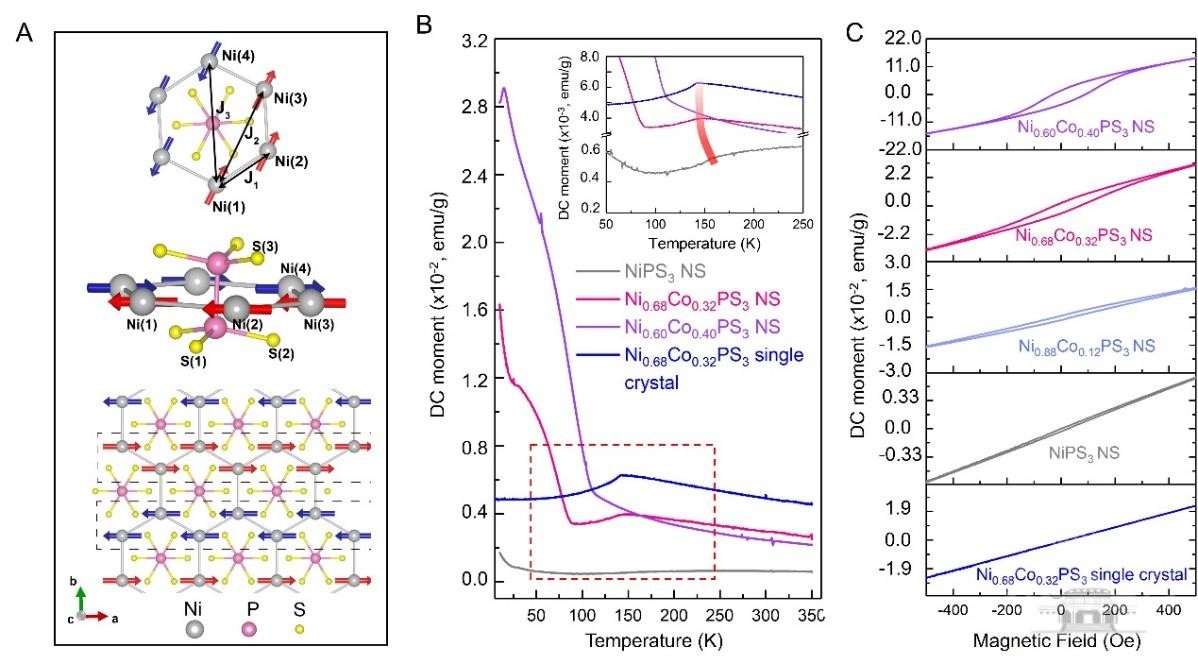Recently, a joint research team consisting of Professor Jun He from the School of Physical Science and Technology of Wuhan University and Professor Song Jin from the University of Wisconsin-Madison has made important progress in the study of the magnetic properties of two-dimensional (2D) transition metal phosphorus sulfides (MPX3, M is a metal element, X is S, Se), and discovered that low-temperature ferromagnetic (FM) properties can be introduced in the intrinsically strongly correlated antiferromagnetic (AFM) van der Waals (vdW) layered Ni1-xCoxPS3 material through S-defect regulation.
The results of the research were published in Science Advances under the title of Defect-Mediated Ferromagnetism in Correlated Two-Dimensional Transition Metal Phosphorus Trisulfides. Professor He Jun and Professor Song Jin are the co-corresponding authors and Wuhan University is the co-signation and corresponding authorship unit.
2D magnetic systems offer a novel arena for studying fundamental magnetism and modulation of low dimensional magnetic properties, also showing significant application prospects in optoelectronic and spintronic devices. Professor He Jun’s research group has long been devoted to the research on controllable synthesis and related devices of 2D magnetic materials. With extensive experience in the field of magnetism, the group has achieved the controllable syntheses of multiple atomically thin materials, including MPX3, CrSe, Cr2S3, Cr2Te3 (Nano Lett. 20, 5, 3130 (2020); Nature Commun. 10, 4133 (2019); Adv. Mater. 31, 1900056 (2019); Nano Lett. 19, 2154 (2019); Adv. Mater. 30, 1707433 (2018); Adv. Funct. Mater. 28, 1800548 (2018). The group has been invited to publish commentaries in Science (Science. 370, 525-526 (2020)).
NiPS3 is a strongly correlated XXZ-type antiferromagnetic vdW material. By solving the XXZ Heisenberg spin model of the system, it is found that there is a strong TNN antiferromagnetic superexchange interaction between the central Ni atom and the third nearest neighbor metal atom via the S atom. In this project, the research group synthesized Co-substituted Ni1−xCoxPS3 NS for the first time. With x-ray absorption spectroscopy and electron spin resonance (ESR) spectroscopy measurements, the incorporation of Sv in Ni1−xCoxPS3 NS is observed, which is promoted by Co substitution of Ni. The calculated formation energy (Ev) of single Sv in Ni1−xCoxPS3 (0 < x < 0.50) is much lower in the case of Ni5Co3P8S24 (1.38 eV) than NiPS3 (2.19 eV). Moreover, magnetic characterization by SQUID shows that the incorporation of Sv in Ni1−xCoxPS3 NS results in the emergence of a weak FM ground state at low temperatures (<100 K), which allows weak ferromagnetism to be achieved through the suppression of AFM correlations at a low applied magnetic field range (<300 Oe). Theoretical calculations suggest that the presence of Sv in Ni1−xCoxPS3 could change the lattice configurations as well as the electronic structures locally and further disrupt the TNN AFM interactions mediated through S atoms, giving rise to weak ferromagnetism in Ni1−xCoxPS3(0≤ x<0.5)NS at low temperatures, which demonstrates the tunable physical properties in the antiferromagnet NiPS3. The study elaborates the mechanism of defect engineering tuning magnetic exchange interactions, providing new routes to the study of 2D magnetic material systems.

(A) The illustrations of the exchange interactions in Ni neighbors in NiPS3 mediated via S atoms and the zigzag antiferromagnetism. (B) Temperature dependence of the ZFC magnetization measured at H = 200 Oe on various Ni1−xCoxPS3 NS and the Ni0.68Co0.32PS3 single crystal. (C) M-H curves measured at 5 K of various Ni1−xCoxPS3 NS.
The research work was supported by the National Key Research and Development Program of the Ministry of Science and Technology and the key research projects
of the National Natural Science Foundation of China.
Link to the paper: https://www.science.org/doi/10.1126/sciadv.abj4086
Rewritten by: Zhou Chuangyu
Edited by Shen Yutian